A two-colour additive process invented in the United Kingdom.
Film Explorer
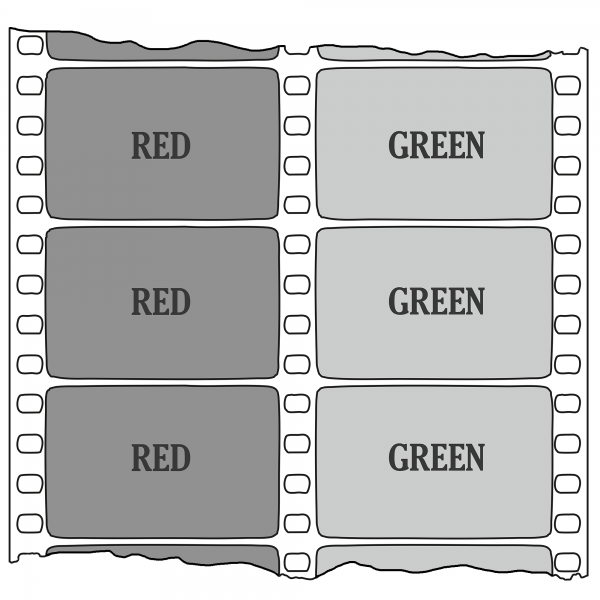
The third version of Cinechrome (c. 1921) captured red and green filtered images side-by-side onto B/W 70mm film.
Design by Christian Zavanaiu.
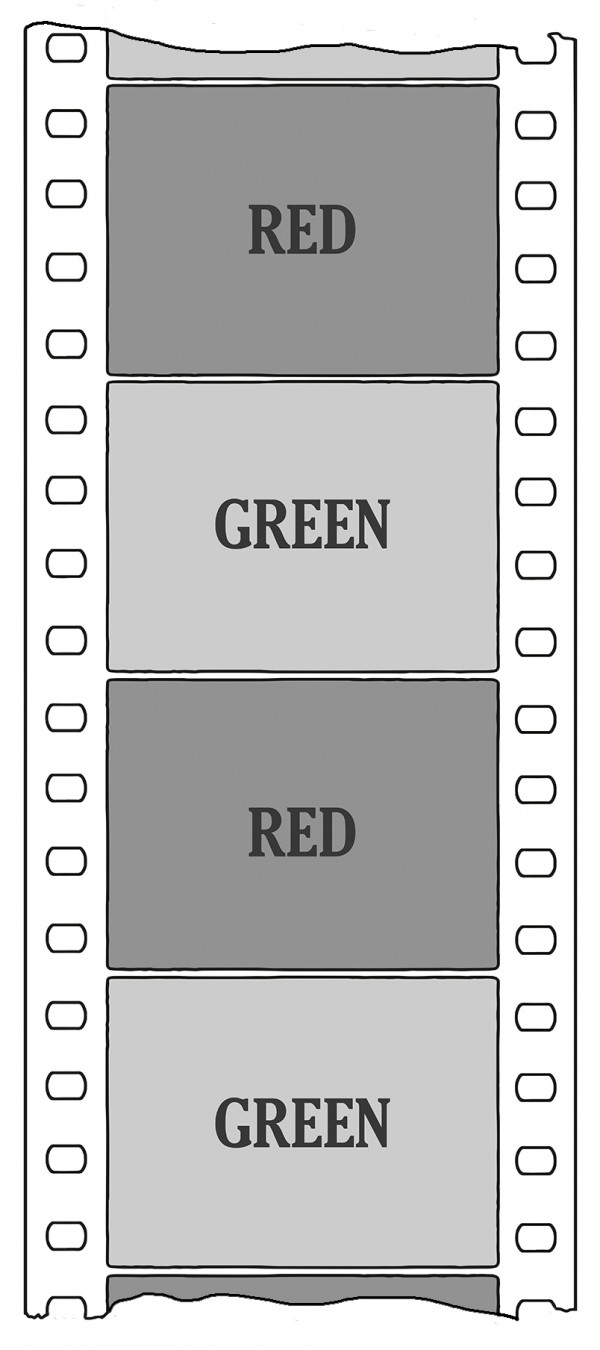
The second proposed version of Cinechrome (c. 1912) used a beam-splitting prism to successively capture red and green filtered images onto B/W 35mm film.
Design by Christian Zavanaiu.
Identification
Approximately 23mm x 17.25mm (0.906 in x 0.679 in).
B/W
1
A two-colour image was displayed onscreen by superimposing two B/W colour-separation records, projected through red-orange and green glass lenses.
Approximately 24mm x 18mm (0.945 in x 0.709 in), though in some iterations of the process, the image might be close to four times smaller.
B/W
History
Cinechrome was adapted from a 1905 patent by William Friese-Greene, which described a system in the camera whereby a prism split the light from the object and passed it through two colour filters, one red-blue and one yellow-orange, and then through the lens, registering two images side by side on the negative. After a brief period running a photographic shop, in 1907 Friese-Greene returned to inventing and continued to develop this process alongside a successive-frame process which would become Biocolour.
At this point the history becomes complicated. An engineer named Allan Ramsay acquired the rights to all of Friese-Greene's patents (excluding the 1905 patent which was not available) and set up a company to develop them, named Friese-Greene Patents Ltd. Friese-Greene was hired as technical director for a period of four years but was lured away by his friend, the exhibitor Walter Harold Speer, who set up Biocolour in 1911 and acquired the services of Friese-Greene plus the rights to the 1905 patent, the only one not owned by Ramsay and Friese-Greene Patents Ltd. Curiously, therefore, despite Friese-Greene Patents Ltd not owning the 1905 patent, the prism system which it outlined formed the basis of the process which the company would ultimately develop, while Biocolour would attempt to exploit the successive-frame system, despite owning the rights to the prism system in the 1905 patent.
In 1911 the film journalist Colin Noel Bennett patented a colour system which used two small lenses, one above the other, placed behind a rotating shutter with cut-away sections which worked in synch to expose two frames simultaneously.
Bennett was adamant in his original 1911 patent that his system did not use a prism and so was not derivative of Davidson and Jumeaux's 1903 patent and, by extension, Friese-Greene's 1905 patent, but these revisions clearly derived from those earlier patents and suggest that Bennett was fostering links with Friese-Greene. Indeed, Bennett granted the rights to his 1911 patent to Friese-Greene, facilitating a link between himself and Friese-Greene Patents Ltd. The company was reformed in 1912 as Colin Bennett Ltd, with financing provided by Sir William Pickles Hartley of Hartley's Jams, whose son-in-law, John Sharp Higham, was on the board of directors. For reasons unknown, at this point Bennett turned his back on inventing and returned to journalism. Further patents refining his process were filed in 1915 under Higham's name and also the names of Frank Twynam and Harold Workman, both of whom worked for a company called Adam Hilger Ltd. That same year Colin Bennett Ltd was re-formed as Cinechrome Ltd, without Bennett but still with Hartley and Higham.
Over the next few years the system underwent further development until it reached the high-point of its success. In 1921 Cinechrome was used to film the state visit of the Prince of Wales – later Edward VIII – to India, which was premiered at the Royal Society of Arts in 1922 and later had a public run at the Stoll Picture Theatre.
The special film and the special projector required to show it proved a stumbling block to commercial exploitation, and the system was revised again, this time by Cox and Demetre Daponte, who had also worked for Adam Hilger Ltd and who took over the running of Cinechrome with Cox in 1922 after Hartley's death.
In 1925 Cox and Daponte renamed the company, and the process, Cinecolor Ltd and the process was adapted again. Commercial success, however, remained elusive. In 1937 the Cinecolor patents were acquired by a holding company, Chromex Ltd, and passed to Dufay-Chromex, which was at that time exploiting the additive Dufaycolor process but looking for ideas to develop a subtractive process.
[Reprinted from Brown, Simon (2012). “Technical Appendix”. In Colour Films in Britain: The Negotiation of Innovation 1900–55, Sarah Street (ed.), pp. 266–8. Basingstoke, Hampshire: Palgrave Macmillan with permission from Bloomsbury Publishing.]
Selected Filmography
This series of the chronicles consisted of episodes about the Prince of Wales’s 41,000-mile-long tour of the Indian Subcontinent that occurred from October 1921 to May 1922. Some of this footage was compiled as separate episodes known as “With the Prince of Wales Through India and Burma”, “Our Greatest Ambassador”, or “Edward Prince of Wales’ Tour of India”, and included chronicles from Madras, Bangalore, Mysore, Hyderabad, Peshawar, Calcutta, Delhi, Bombay, Poona, Bikaner, Lucknow, Benares, Nepal, Malakand and Kapurthala. The director George Woods-Taylor photographed the events in both B/W and colour versions. Surprisingly, George Albert Smith, the inventor of Kinemacolor, also most probably accompanied the tour. The original length of the film was six two-reelers, but only selected B/W episodes survive, archived at the British Film Institute.
This series of the chronicles consisted of episodes about the Prince of Wales’s 41,000-mile-long tour of the Indian Subcontinent that occurred from October 1921 to May 1922. Some of this footage was compiled as separate episodes known as “With the Prince of Wales Through India and Burma”, “Our Greatest Ambassador”, or “Edward Prince of Wales’ Tour of India”, and included chronicles from Madras, Bangalore, Mysore, Hyderabad, Peshawar, Calcutta, Delhi, Bombay, Poona, Bikaner, Lucknow, Benares, Nepal, Malakand and Kapurthala. The director George Woods-Taylor photographed the events in both B/W and colour versions. Surprisingly, George Albert Smith, the inventor of Kinemacolor, also most probably accompanied the tour. The original length of the film was six two-reelers, but only selected B/W episodes survive, archived at the British Film Institute.
Technology
Version 1: 35mm twin-lenses, successive images
In 1911 the film journalist Colin Noel Bennett patented a colour system which used two small lenses, one above the other, placed behind a rotating shutter with cut-away sections which worked in synch to expose two frames simultaneously [on 35mm film]. Before the lenses were two filters, one red and one green. Both the red and green images were therefore recorded simultaneously but successively.
A further patent in 1912 was for a complementary projection system wherein light from the source passed through red and green filters and through two lenses, the upper of which was adjustable in order to accomplish precise register with the lower and ensure the picture on screen was in focus. The film gate was double the width, so the light passed through two frames at once, and the projector moved the film on two frames at a time.
Version 2: 35mm beam-splitting prism, successive images
Further patents in 1912 refined the system, abandoning the use of two small lenses in the camera and replacing it with a prism that split the light so that it passed through two filters and recorded the images successively. It was later refined again so that the two images were recorded in a smaller size side by side on a single film frame.
Version 3: 70mm film, side-by-side images
In 1921–1922 the process used a prism which split the beam of light from the object and recorded two colour records side by side on an extra-wide film [presumably 70mm] with perforations down both sides and in the middle. After 1922 the wide film was dispensed with and the two images were registered sideways on a single 35mm frame.Version 4: 35mm film, side-by-side images
In 1925 the process was adapted again, dispensing with the two sideways images in favour of two images registered the right way up in a single frame and a projection system which used an adjustable prism to enable the two images to be registered precisely – a system ironically not far removed from that originally proposed by Bennett in 1911.
[Reprinted from Brown, Simon (2012). “Technical Appendix”. In Colour Films in Britain: The Negotiation of Innovation 1900–55, Sarah Street (ed.), pp. 266–8. Basingstoke, Hampshire: Palgrave Macmillan with permission from Bloomsbury Publishing.]
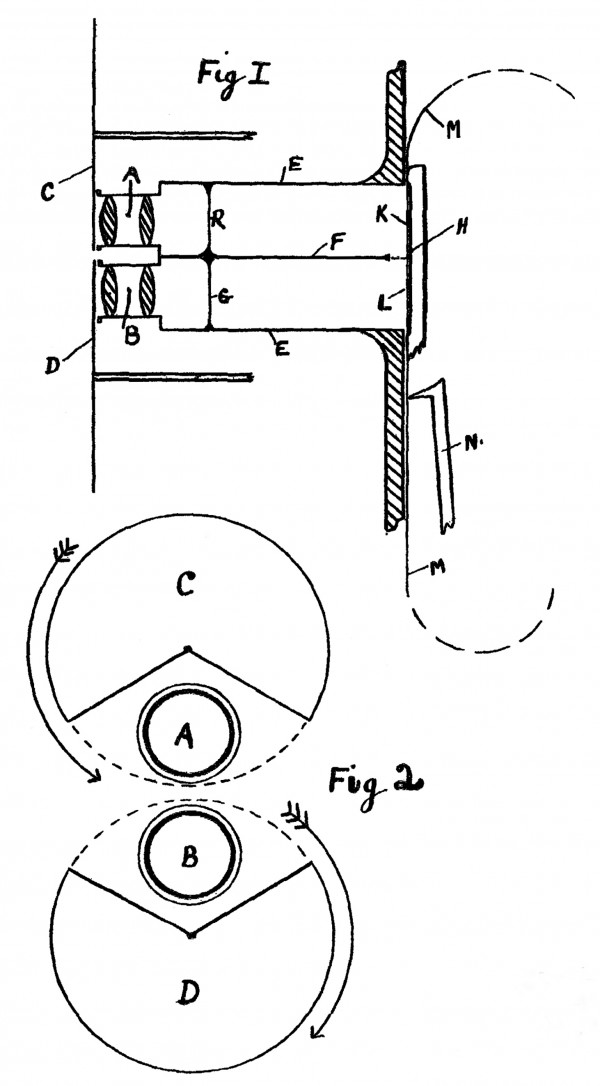
Bennett’s first version of the colour system used two small lenses, one above the other. The lenses were placed behind a rotating shutter which worked in sync, to expose two frames simultaneously on 35mm film, one above the other, one through a red filter and one through green filter.
Colin Noel Bennett. An Improvement Form of Camera for Colour Cinematography. British Patent 1,642, filed Jan. 21, 1911; granted Oct. 12, 1911.
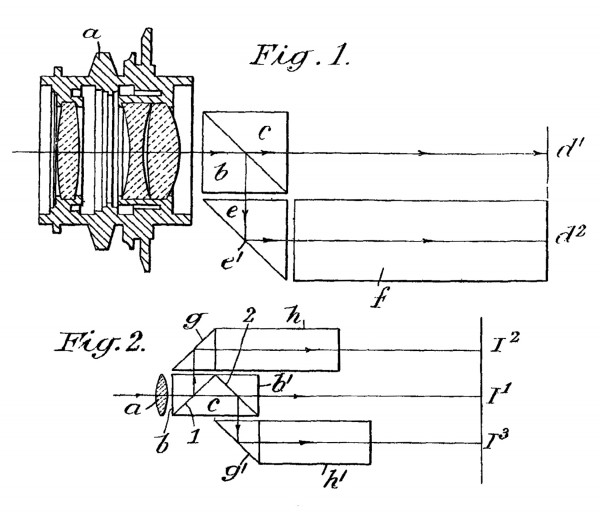
Beam-splitting prism, c. 1912. The drawback of using two lenses in camera was a stereoscopic effect so the idea was revised by Bennett and optician Conrad Beck. They offered to use one lens together with a compound prism capable of dividing the light into two separate paths, creating two optically identical images onto one strip of 35mm film.
Colin Noel Bennett & Conrad Beck. Improvements in Apparatus for taking or Projecting Photographic Pictures. British Patent 24,159, filed Oct. 22, 1912; granted Oct. 22, 1913.
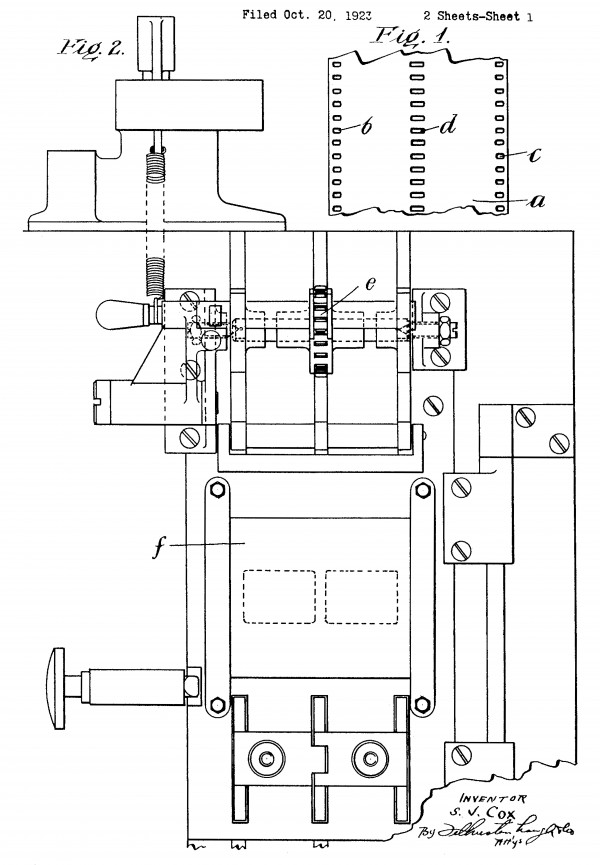
In the early 1920s, the Cinechrome process was revised again with a new radical iteration which used double-wide 70mm film to capture two images side-by-side through a beam-splitting prism behind the lens. It was this version of the process which was used to film the visit of the Prince of Wales to India in 1922.
Samuel James Cox. Cinechrome Instruments, Ltd. Cinematography. US1593796A, filed Oct. 20, 1923, granted Jul 27, 1926.
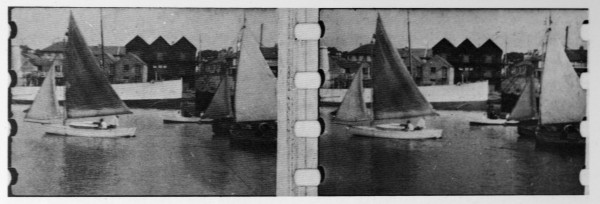
Unidentified film, c. 1922. The third iteration of the Cinechrome process used 70mm film to record two images side-by-side, on B/W film, for two-colour additive projection through coloured filters.
Coe, Brian (1981). The History of Movie Photography. London: Ash & Grant, p. 120.
References
Anon. (“Tripod”) (1921). “Cameramen at Work”. The Motion Picture Studio, 1:18 (October 8): p. 11.
Anon. (1924). British Journal of Photography, 71 (48pp Colour Supplement) (Feb. 1): p. 5.
Bennett, Colin N. (1911). The Notebook of Kinematography: The History, Theory and Practice of Motion Photography and Projection, pp. 259–306. London: The Kinematograph Weekly.
Board of Trade (1908). BT 31/18498/98940, Friese-Greene Patents Ltd. Kew, United Kingdom: National Archives.
Board of Trade (1912). BT 31/21043/125384, Colin Bennett Ltd. Kew, United Kingdom: National Archives.
Board of Trade (1915). BT 31/22949/141281 Cinechrome Ltd. Kew, United Kingdom: National Archives.
Brown, Simon (2012). “The Brighton School and the Quest for Natural Colour – Redux”. In Colour and the Moving Image, Simon Brown, Sarah Street & Liz Watkins (eds), pp. 13–22. New York: Routledge.
Coe, Brian (1980). The History of Movie Photography. London: Ash & Grant.
McKernan, Luke (2004). “The Brighton School and the Quest for Natural Colour”. In Visual Delights Two: Exhibition and Reception, Vanessa Toulmin & Simon Popple (eds), pp. 205–18. Sydney: John Libbey and Co.
Society of Motion Picture Engineers (1924). “Progress in the Motion Pictures Industry”. Transactions of the SMPE, 19 (Sep.–Oct.): pp. 9–10.
Patents
Bennett, Colin Noel. An Improvement Form of Camera for Colour Kinematography. British Patent 1,642, filed Jan. 21, 1911; granted Oct. 12, 1911.
Bennett, Colin Noel. Means for Projecting Films in Colour Kinematography. British Patent 1,900, filed Jan. 24, 1912; granted Oct. 31, 1912.
Bennett, Colin Noel. Improvements in Colour Kinematography and in Apparatus therefor. British Patent 10,639, filed May 4, 1912; granted May 1, 1913.
Bennett, Colin Noel, Conrad Beck. Improvements in Apparatus for taking or Projecting Photographic Pictures. British Patent 24,159, filed Oct. 22, 1912; granted Oct. 22, 1913.
Bennett, Colin Noel. Improvements in or Apparatus for Printing Cinematograph Films. British Patent 26,173, filed Nov. 14, 1912; granted Oct. 2, 1913.
Twyman, Frank, John Sharp Higham, Harold Workman. Optical Appliances for Two-Colour Helichromy. British Patent 16,810, filed Nov. 29, 1915; granted Nov. 29, 1916.
Twyman, Frank, John Sharp Higham, Harold Workman. Optical Appliances for Two-Colour Helichromy. British Patent 16,811, filed Nov. 29, 1915; granted Nov. 29, 1916.
Hillman, Albert George, Cinechrome Instruments, Ltd. Intermittent feed mechanism. US1400877A, filed Jun. 26, 1920, granted Dec. 12, 1921.
Cox, Samuel James, Cinechrome Instruments, Ltd. Improvements in and Relating to Cinematography. GB206003A, filed Oct. 24, 1922; granted Nov. 1, 1923.
Hillman, Albert George, Cinechrome Instruments, Ltd. Improvements in Kinematographs and like Apparatus for Producing Effect of Motion. GB206682A, filed Oct. 10, 1922; granted Nov. 15, 1923.
Reed, Percy Alfred, Cinechrome Instruments, Ltd. Intermittent Feed Mechanism for Cinematographic Apparatus. US1480864A, filled Jan. 10, 1921, granted Jan. 15, 1924.
Cox, Samuel James, Cinechrome Instruments, Ltd. Cinematography. US1593796A, filed Oct. 20, 1923, granted Jul 27, 1926.
Followed by
Compare
Related entries
Authors
Simon Brown is Associate Professor of Film and Television at Kingston University, London, UK. He has written extensively on many aspects of film history and technology – including early, silent and British cinema, 3D and colour cinematography. His publications include the monograph Cecil Hepworth and the Rise of the British Film Industry 1899–1911 (University of Exeter Press, 2016) a Technical Appendix on colour film processes in Colour Films in Britain: The Negotiation of Innovation 1900–1955 by Sarah Street (BFI Publishing, 2012) and the online article “Dufaycolor: The Spectacle of Reality and British National Cinema” (2002) – available at http://www.bftv.ac.uk/projects/dufaycolor.htm.
Oleksandr Teliuk is a film scholar, archivist and artist. As a film archivist and programmer, he worked at the Dovzhenko Center, Ukrainian State Film Archive. He was co-curator of film programmes and exhibitions at the Film Museum of Dovzhenko Center, including “VUFKU: Lost & Found” (2019); co-editor of books (Cinematographic Revision of Donbas [2017, 2018], Chornobyl (In)Visible [2017] and Ukrainian Film Critic Anthology of the 1920s [2018—2022]); curator of numerous film programmes of Ukrainian archival cinema at international film festivals. He is a graduate of the L. Jeffrey Selznick School of Film Preservation (2024).
The History, Technology and References sections are written by Simon Brown using text reprinted from the Technical Appendix of Colour Films in Britain: The Negotiation of Innovation 1900–55 (2012). All other text was written or compiled by Oleksandr Teliuk.
Brown, Simon & Oleksandr Teliuk (2024). “Cinechrome”. In James Layton (ed.), Film Atlas. www.filmatlas.com. Brussels: International Federation of Film Archives / Rochester, NY: George Eastman Museum.


